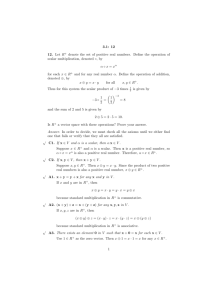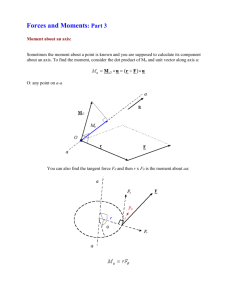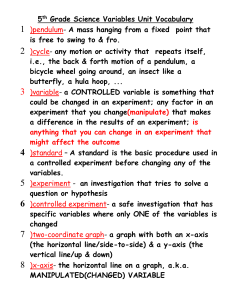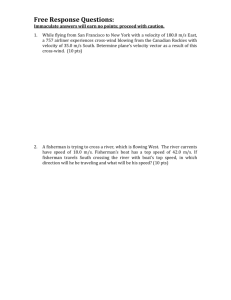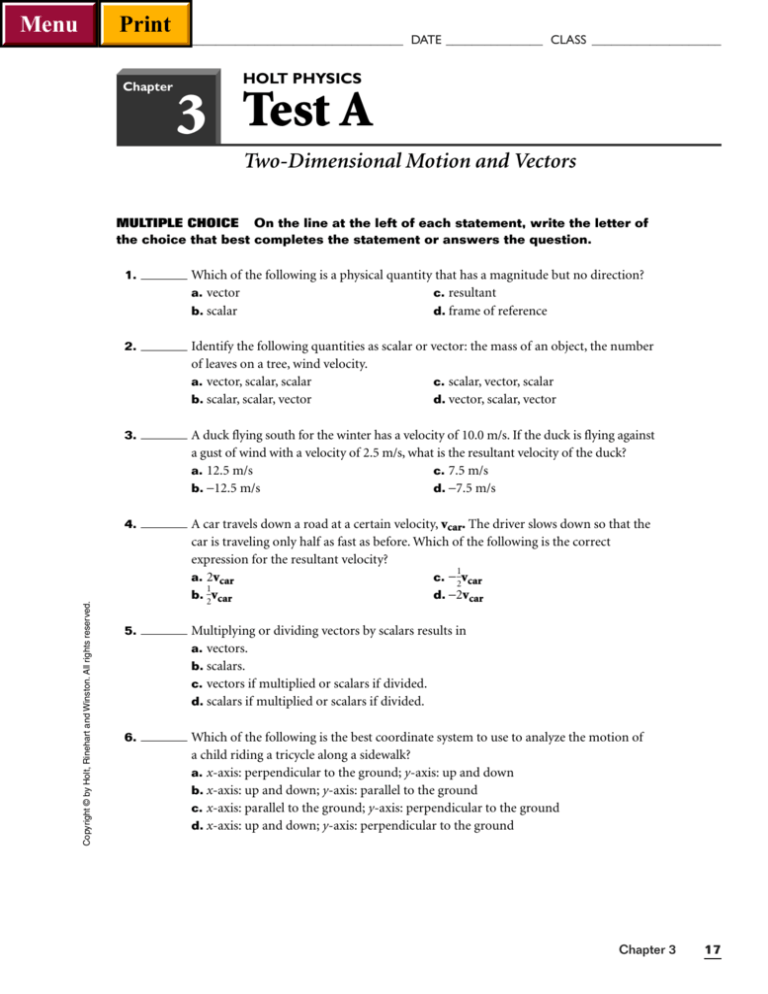
Menu
Print
NAME ______________________________________ DATE _______________ CLASS ____________________
Chapter
HOLT PHYSICS
3 Test A
Two-Dimensional Motion and Vectors
Copyright © by Holt, Rinehart and Winston. All rights reserved.
MULTIPLE CHOICE On the line at the left of each statement, write the letter of
the choice that best completes the statement or answers the question.
1.
Which of the following is a physical quantity that has a magnitude but no direction?
a. vector
c. resultant
b. scalar
d. frame of reference
2.
Identify the following quantities as scalar or vector: the mass of an object, the number
of leaves on a tree, wind velocity.
a. vector, scalar, scalar
c. scalar, vector, scalar
b. scalar, scalar, vector
d. vector, scalar, vector
3.
A duck flying south for the winter has a velocity of 10.0 m/s. If the duck is flying against
a gust of wind with a velocity of 2.5 m/s, what is the resultant velocity of the duck?
a. 12.5 m/s
c. 7.5 m/s
b. −12.5 m/s
d. −7.5 m/s
4.
A car travels down a road at a certain velocity, vcar. The driver slows down so that the
car is traveling only half as fast as before. Which of the following is the correct
expression for the resultant velocity?
1
a. 2vcar
c. − 2vcar
1
b. 2vcar
d. −2vcar
5.
Multiplying or dividing vectors by scalars results in
a. vectors.
b. scalars.
c. vectors if multiplied or scalars if divided.
d. scalars if multiplied or scalars if divided.
6.
Which of the following is the best coordinate system to use to analyze the motion of
a child riding a tricycle along a sidewalk?
a. x-axis: perpendicular to the ground; y-axis: up and down
b. x-axis: up and down; y-axis: parallel to the ground
c. x-axis: parallel to the ground; y-axis: perpendicular to the ground
d. x-axis: up and down; y-axis: perpendicular to the ground
Chapter 3
17
Menu
Print
NAME ______________________________________ DATE _______________ CLASS ____________________
3
HOLT PHYSICS
continued
Test A
7.
Which of the following is the best coordinate system to use to analyze the motion of
a car traveling northeast from one city to another?
a. positive x-axis pointing east; positive y-axis pointing south
b. positive x-axis pointing west; positive y-axis pointing east
c. positive x-axis pointing north; positive y-axis pointing south
d. positive x-axis pointing east; positive y-axis pointing north
8.
In a coordinate system, if the x component of a vector and the angle between the
vector and x-axis are known, then the magnitude of the vector is calculated by which
operation, taken with respect to the x component?
a. dividing by the sine of q
c. multiplying by the sine of q
b. dividing by the cosine of q
d. multiplying by the cosine of q
9.
Which of the following is an example of projectile motion?
a. a jet lifting off a runway
b. a bullet being fired from a gun
c. dropping an aluminum can into the recycling bin
d. a space shuttle orbiting Earth
10.
Which of the following exhibits parabolic motion?
a. a person diving into a pool from a diving board
b. a space shuttle orbiting Earth
c. a leaf falling from a tree
d. a train moving along a flat track
11.
A piece of chalk is dropped by a teacher walking at a speed of 1.5 m/s. From the
teacher’s perspective, the chalk appears to fall
a. straight down.
b. straight down and backward.
c. straight down and forward.
d. straight backward.
18
Holt Physics Chapter Tests
Copyright © by Holt, Rinehart and Winston. All rights reserved.
Chapter
Menu
Print
NAME ______________________________________ DATE _______________ CLASS ____________________
Chapter
Copyright © by Holt, Rinehart and Winston. All rights reserved.
3
HOLT PHYSICS
continued
Test A
12.
A jogger runs 10.0 blocks due east, 5.0 blocks due south, and another 2.0 blocks due
east. Assume all blocks are of equal size. Use the graphical method (drawing the
route) to find the magnitude of the jogger’s net displacement.
a. 14.0 blocks
c. 11.0 blocks
b. 8.0 blocks
d. 13.0 blocks
13.
A cave explorer travels 3.0 m eastward, then 2.5 m northward, and finally 15 m
westward. Use the graphical method to find the magnitude of the net displacement.
a. 12 m
c. 18 m
b. 5.7 m
d. 15 m
14.
An ant on a picnic table travels 30 cm eastward, then 25 cm northward, and finally
15 cm westward. What is the ant’s directional displacement relative to its original
position?
a. 29 cm at 59° north of east
c. 57 cm at 29° north of west
b. 52 cm at 29° north of east
d. 29 cm at 77° north of east
15.
A quarterback takes the ball from the line of scrimmage and runs backward for 10 m,
then sideways parallel to the line of scrimmage for 15 m. The ball is thrown forward
50 m perpendicular to the line of scrimmage. The receiver is tackled immediately.
How far is the football displaced from its original position?
a. 43 m
c. 62 m
b. 55 m
d. 75 m
Chapter 3
19
Menu
Print
NAME ______________________________________ DATE _______________ CLASS ____________________
3
HOLT PHYSICS
continued
Test A
16.
An athlete runs 110 m across a level field at an angle of 30.0° north of east. What are
the east and north components, respectively, of this displacement?
a. 64 m, 190 m
c. 95 m, 55 m
b. 190 m, 64 m
d. 55 m, 95 m
17.
Vector A is 3 units in length and points along the positive x-axis. Vector B is 4 units in
length and points along a direction 150° from the positive x-axis. What is the
direction of the resultant relative to the positive x-axis?
a. 80°
c. 90°
b. 10°
d. 100°
18.
A hiker walks 4.5 km at an angle of 45° north of west. Then the hiker walks 4.5 km
south. What is the magnitude and direction of the hiker’s total displacement?
a. 3.5 km, 22° south of west
c. 6.4 km, 45° north of west
b. 3.5 km, 22° north of west
d. 6.4 km, 22° south of west
19.
A superhero flying at treetop level sees the Eiffel Tower elevator begin to free fall. If
the superhero is 1.00 km away from the tower and the elevator falls from a height of
240.0 m, how long does the superhero have to save the people in the elevator? What
should the superhero’s average velocity be?
a. 7 s; 333 m/s
c. 7 s; 147 m/s
b. 5 s; 200 m/s
d. 9 s; 111 m/s
SHORT ANSWER
provided.
Write the answer to the following question in the space
20. Briefly explain why a basketball being thrown toward the hoop is considered projectile motion.
20
Holt Physics Chapter Tests
Copyright © by Holt, Rinehart and Winston. All rights reserved.
Chapter
Menu
Print
NAME ______________________________________ DATE _______________ CLASS ____________________
Chapter
HOLT PHYSICS
3 Test B
Two-Dimensional Motion and Vectors
Copyright © by Holt, Rinehart and Winston. All rights reserved.
MULTIPLE CHOICE On the line at the left of each statement, write the letter of
the choice that best completes the statement or answers the question.
1.
Which of the following is a physical quantity that has a magnitude and direction?
a. vector
c. resultant
b. scalar
d. frame of reference
2.
Identify the following quantities as scalar or vector: the speed of a snail, the time it
takes to run a mile, and the free-fall acceleration.
a. vector, scalar, scalar
c. vector, scalar, vector
b. scalar, scalar, vector
d. scalar, vector, vector
3.
A lightning bug flies at a velocity of 0.25 m/s due east toward another lightning bug
seen off in the distance. A light breeze from the east blows on the bug at a velocity of
0.25 m/s. What is the resultant velocity of the lightning bug?
a. 0.50 m/s
c. 0.75 m/s
b. 0.00 m/s
d. 0.25 m/s
4.
A student adds two scalars with magnitudes of 200 and 40. If significant figures are
taken into account, which is the only possible choice for the magnitude of the
resultant?
a. 160
c. 300
b. 200
d. 240
5.
Multiplying or dividing vectors by scalars results in
a. vectors.
b. scalars.
c. vectors if multiplied or scalars if divided.
d. scalars if multiplied or scalars if divided.
6.
An airplane flying at 120 km/h due west moves into a region where the wind is
blowing at 40 km/h due east. If the plane’s original vector velocity is vplane, which of
the following is the correct expression for the resulting velocity?
2
3
a. 3vplane
c. 4vplane
1
b. − 3vplane
2
d. − 3vplane
Chapter 3
21
Menu
Print
NAME ______________________________________ DATE _______________ CLASS ____________________
3
HOLT PHYSICS
continued
Test B
7.
Which of the following is the best coordinate system to analyze a painter climbing a
ladder at an angle of 60° to the ground?
a. x-axis: horizontal along the ground; y-axis: along the ladder
b. x-axis: up and down; y-axis: horizontal along the ground
c. x-axis: horizontal along the ground; y-axis: up and down
d. x-axis: along the ladder; y-axis: up and down
8.
Which of the following is the best coordinate system to analyze an object thrown into
the air?
a. x-axis: perpendicular to the ground; y-axis: up and down
b. x-axis: up and down; y-axis: parallel to the ground
c. x-axis: parallel to the ground; y-axis: perpendicular to the ground
d. x-axis: up and down; y-axis: perpendicular to the ground
9.
In a coordinate system, the x-component of a given vector is equal to that vector’s
magnitude multiplied by which trigonometric function, with respect to the angle
between the vector and the x-axis?
a. the cosine of q
c. the tangent of q
b. the sine of q
d. the cotangent of q
10.
Which of the following is NOT an example of projectile motion?
a. a volleyball served over a net
b. a baseball hit by a bat
c. a hot-air balloon drifting toward Earth
d. a long jumper in action
11.
A passenger on a bus moving east sees a man standing on a curb. From the passenger’s
perspective, the man appears to
a. stand still.
b. move west at a speed that is less than the bus’s speed.
c. move west at a speed that is equal to the bus’s speed.
d. move east at a speed that is equal to the bus’s speed.
12.
A cave explorer travels 3.0 m eastward, then 2.5 m northward, and finally 15 m
westward. Use the graphical method to find the magnitude of the net displacement.
a. 12 m
c. 18 m
b. 5.7 m
d. 15 m
22
Holt Physics Chapter Tests
Copyright © by Holt, Rinehart and Winston. All rights reserved.
Chapter
Menu
Print
NAME ______________________________________ DATE _______________ CLASS ____________________
Chapter
Copyright © by Holt, Rinehart and Winston. All rights reserved.
3
HOLT PHYSICS
continued
Test B
13.
While following directions on a treasure map, a person walks 45.0 m south, then turns
and walks 7.50 m east. Which single straight-line displacement could the treasure
hunter have walked to reach the same spot?
a. 45.6 m at 9.5° south of east
b. 52.5 m at 21° east of south
c. 45.6 m at 9.5° east of south
d. 45.6 m at 21° south of east
14.
An athlete runs 110 m across a level field at an angle of 30.0° north of east. What are
the east and north components, respectively, of this displacement?
a. 64 m, 190 m
c. 95 m, 55 m
b. 190 m, 64 m
d. 55 m, 95 m
15.
Find the resultant of these two vectors: 2.00 × 102 units due east and 4.00 × 102 units
30.0° north of west.
a. 300 units 29.8° north of west
b. 581 units 20.1° north of east
c. 546 units 59.3° north of west
d. 248 units 53.9° north of west
16.
What is the resultant displacement of a dog looking for its bone in the yard, if the dog
first heads 55° north of west for 10.0 m, then turns and heads west for 5.0 m?
a. 11.2 m at 63° west of north
b. 13.5 m at 37° north of west
c. 13.5 m at 37° north of east
d. 62.1 m at 74° north of west
17.
A model rocket flies horizontally off the edge of the cliff at a velocity of 50.0 m/s. If
the canyon below is 100.0 m deep, how far from the edge of the cliff does the model
rocket land?
a. 112 m
c. 337 m
b. 225 m
d. 400 m
18.
A superhero flying at treetop level sees the Eiffel Tower elevator begin to free fall. If
the superhero is 1.00 km away from the tower and the elevator falls from a height of
240.0 m, how long does the superhero have to save the people in the elevator? What
should the superhero’s average velocity be?
a. 7 s; 333 m/s
c. 7 s; 147 m/s
b. 5 s; 200 m/s
d. 9 s; 111 m/s
Chapter 3
23
Menu
Print
NAME ______________________________________ DATE _______________ CLASS ____________________
Chapter
3
HOLT PHYSICS
continued
Test B
SHORT ANSWER
provided.
Write the answer to the following question in the space
19. Briefly explain why the true path of a projectile traveling through Earth’s atmosphere is not a
parabola.
PROBLEM Write your answer to the question on the line to the left, and show
your work in the space provided.
A dog walks 24 steps north and then walks 55 steps west to bury a bone. If the dog
walks back to the starting point in a straight line, how many steps will the dog take
and in which direction will the dog walk? Use the graphical method to find the
magnitude of the net displacement.
Copyright © by Holt, Rinehart and Winston. All rights reserved.
20.
24
Holt Physics Chapter Tests
Menu
Print
Chapter 3 Test Form A
Chapter 3 Test Form B
1. B
2. B
3. C
4. B
5. A
6. B
7. D
8. B
9. B
10. A
11. A
12. D
13. A
14. A
15. A
16. C
17. C
18. A
19. C
20. Objects sent into the air with an initial velocity
1. A
2. B
3. B
4. B
5. A
6. A
7. C
8. C
9. A
10. C
11. C
12. A
13. C
14. C
15. D
16. B
17. B
18. C
19. With air resistance, a projectile slows down as it
collides with air particles. Therefore, the true
path of a projectile would not be a parabola.
20. 60 steps 24° S of E
Copyright © by Holt, Rinehart and Winston. All rights reserved.
and subject to gravity exhibit projectile motion.
Answer Key
203



